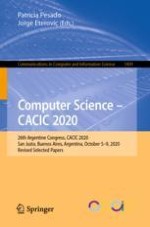This book constitutes revised selected papers from the 26th Argentine Congress on Computer Science, CACIC 2020, held in San Justo, Buenos Aires, Argentina in October 2020. Due to the COVID-19 pandemic the conference was held in a virtual mode.
The 21 full papers and 3 short papers presented in this volume were carefully reviewed and selected from a total of 118 submissions. They were organized in topical sections named: intelligent agents and systems; distributed and parallel processing; computer technology applied to education; graphic computation, images and visualization; software engineering; databases and data mining; hardware architectures, networks, and operating systems; innovation in software systems; signal processing and real-time systems; innovation in computer science education; computer security; and digital governance and smart cities.
